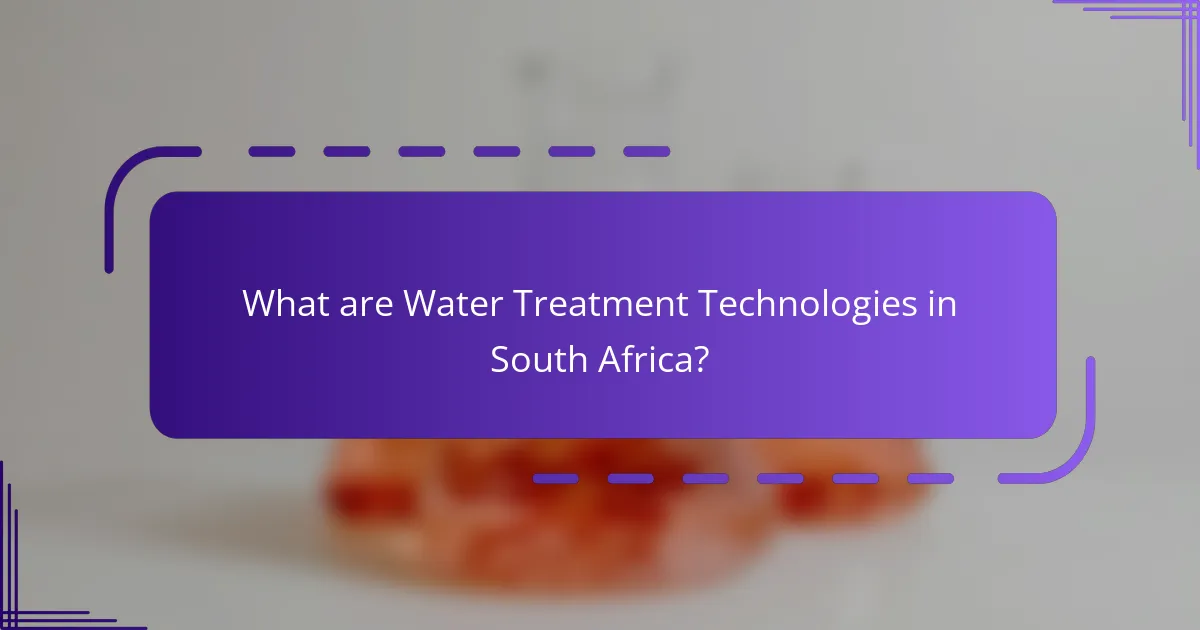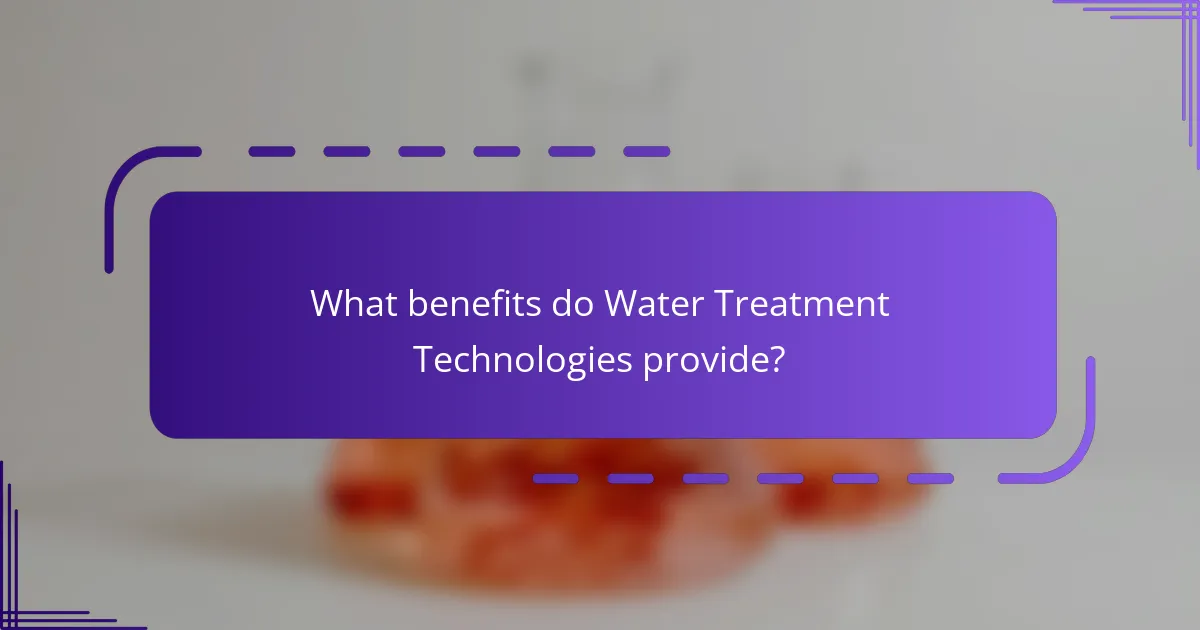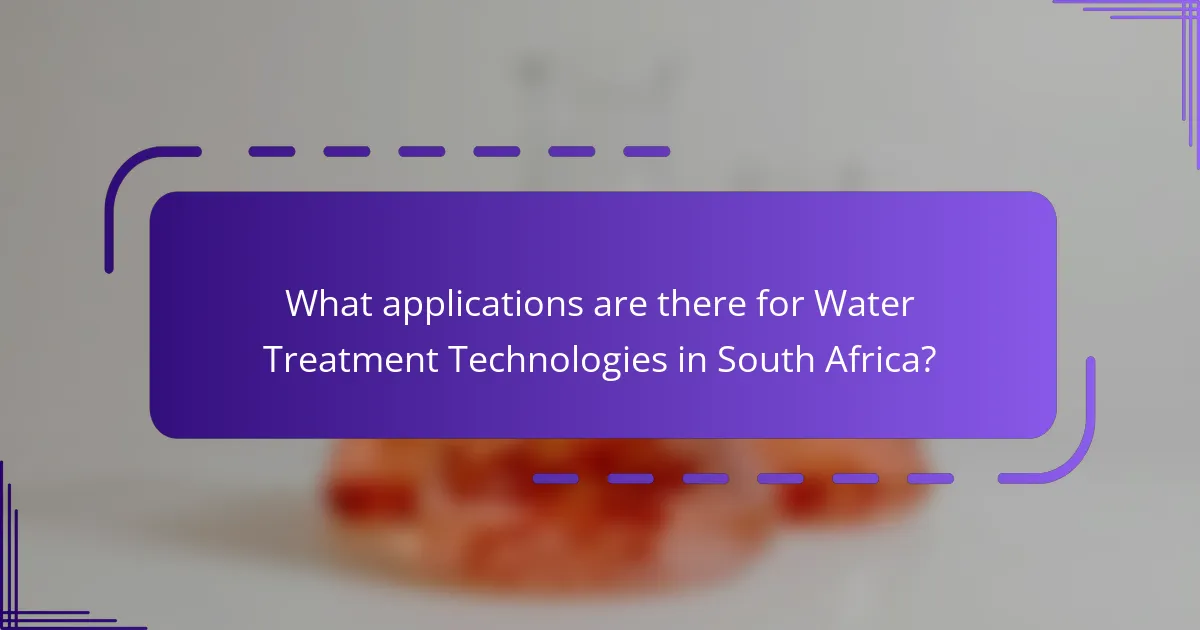Water treatment technologies in South Africa encompass various methods for purifying water to address challenges such as water scarcity and contamination. Key technologies include reverse osmosis, filtration, and disinfection methods like chlorination and UV treatment, all crucial for ensuring safe drinking water. These technologies not only improve water quality but also play a significant role in public health, environmental protection, and sustainable water management. Applications range from municipal water supply and industrial water treatment to wastewater management and desalination, highlighting their importance in maintaining water availability and quality across the country.

What are Water Treatment Technologies in South Africa?
Water treatment technologies in South Africa include various methods for purifying water. These technologies address challenges like water scarcity and contamination. Common methods include reverse osmosis, filtration, and disinfection. Reverse osmosis removes impurities through a semi-permeable membrane. Filtration uses physical barriers to separate particles from water. Disinfection methods, such as chlorination and UV treatment, eliminate harmful microorganisms. According to the Department of Water and Sanitation, these technologies are vital for ensuring safe drinking water. The use of advanced treatment processes is essential in urban and rural areas alike.
How do Water Treatment Technologies function?
Water treatment technologies function by removing contaminants from water to make it safe for consumption and use. These technologies employ various methods, including physical, chemical, and biological processes. Physical processes involve filtration and sedimentation to separate solid particles from water. Chemical processes utilize substances like chlorine or ozone to disinfect water and eliminate pathogens. Biological processes often involve microorganisms that break down organic matter in wastewater. Advanced technologies, such as reverse osmosis, use membranes to remove dissolved solids and impurities. Each method is designed to address specific contaminants based on water quality needs. In South Africa, these technologies are crucial for ensuring access to clean water amidst challenges like water scarcity and pollution.
What processes are involved in Water Treatment Technologies?
Water treatment technologies involve several key processes. These processes include coagulation, flocculation, sedimentation, filtration, and disinfection. Coagulation adds chemicals to water to destabilize particles. Flocculation follows, where these destabilized particles form larger aggregates. Sedimentation allows these aggregates to settle out of the water. Filtration then removes remaining particles and impurities. Finally, disinfection eliminates pathogens, ensuring water safety. Each of these processes is essential for producing clean and safe drinking water.
How do these processes ensure water quality?
Water treatment processes ensure water quality by removing contaminants and pathogens. These processes include filtration, disinfection, and chemical treatment. Filtration physically removes particles and sediments from water. Disinfection eliminates harmful microorganisms through methods like chlorination or UV radiation. Chemical treatment adjusts pH levels and adds coagulants to enhance sedimentation. Each process is monitored to meet safety standards. In South Africa, the Department of Water and Sanitation sets specific quality guidelines. Regular testing confirms compliance with these standards. This systematic approach guarantees safe drinking water for communities.
What are the key types of Water Treatment Technologies used in South Africa?
The key types of water treatment technologies used in South Africa include conventional treatment, membrane filtration, and advanced oxidation processes. Conventional treatment involves coagulation, sedimentation, and filtration to remove contaminants. Membrane filtration utilizes semi-permeable membranes to separate particles and impurities from water. Advanced oxidation processes involve the generation of hydroxyl radicals to degrade organic pollutants. These technologies are essential for ensuring safe drinking water and managing wastewater effectively. The implementation of these methods addresses water quality challenges in the region.
What is the role of physical treatment methods?
Physical treatment methods play a crucial role in water treatment by removing physical contaminants from water. These methods include processes like sedimentation, filtration, and flotation. Sedimentation allows heavier particles to settle at the bottom of a tank, effectively clarifying the water. Filtration uses various media to capture smaller particles, ensuring cleaner water. Flotation involves introducing air bubbles that attach to particles, aiding their removal. These processes are essential for producing safe drinking water and protecting public health. In South Africa, the effective application of physical treatment methods is vital due to challenges like water scarcity and pollution.
How do chemical treatment methods differ from physical methods?
Chemical treatment methods involve the use of chemicals to alter water properties, while physical methods rely on physical processes. Chemical methods include coagulation, chlorination, and disinfection. These methods target specific contaminants through chemical reactions. For example, chlorine is used to kill bacteria and viruses.
Physical methods include filtration, sedimentation, and adsorption. These rely on physical forces to remove impurities. For instance, sand filters physically trap particles as water passes through.
The effectiveness of chemical methods often depends on water chemistry. In contrast, physical methods are generally more straightforward and do not alter chemical composition. Both methods are essential in water treatment, with distinct roles in ensuring water quality.
What innovative technologies are emerging in water treatment?
Innovative technologies emerging in water treatment include advanced oxidation processes, membrane filtration, and bioreactor systems. Advanced oxidation processes utilize powerful oxidants to break down contaminants. Membrane filtration technologies, such as reverse osmosis, effectively remove impurities from water. Bioreactor systems leverage microorganisms to treat wastewater efficiently. These technologies enhance water quality and sustainability. Research indicates that membrane filtration can achieve over 99% removal of certain contaminants. Advanced oxidation processes have been shown to reduce chemical oxygen demand significantly. Implementing these technologies can lead to safer and cleaner water supplies.

What benefits do Water Treatment Technologies provide?
Water treatment technologies provide essential benefits for public health and environmental protection. They ensure the removal of contaminants from water sources. This process improves water quality, making it safe for consumption. Additionally, these technologies help in the preservation of ecosystems. They reduce pollution levels in rivers and lakes. Effective water treatment can also aid in sustainable water management. According to the World Health Organization, improved water quality reduces waterborne diseases significantly. In South Africa, these technologies support community health and economic development.
How do these technologies improve public health?
Water treatment technologies improve public health by ensuring access to safe drinking water. These technologies eliminate harmful pathogens and contaminants from water sources. For instance, filtration and disinfection processes significantly reduce waterborne diseases. According to the World Health Organization, improved water quality can decrease diarrheal diseases by up to 50%. Additionally, these technologies promote better hygiene practices by providing clean water for sanitation. Effective water treatment also supports community health initiatives and reduces healthcare costs associated with water-related illnesses. In South Africa, advancements in water treatment have led to a decline in cholera outbreaks, showcasing their impact on public health.
What impact do they have on disease prevention?
Water treatment technologies significantly impact disease prevention. They reduce pathogens and contaminants in drinking water. Effective treatments lower the risk of waterborne diseases like cholera and typhoid. For example, chlorination can eliminate 99.9% of bacteria in water. Filtration systems also remove harmful particles and viruses. In South Africa, improved water quality has led to decreased disease outbreaks. Studies show that access to treated water correlates with better public health outcomes. Therefore, water treatment technologies play a crucial role in safeguarding community health.
How do they ensure safe drinking water?
They ensure safe drinking water through various water treatment technologies. These technologies include filtration, chlorination, and reverse osmosis. Filtration removes particulates and contaminants from the water. Chlorination disinfects by killing harmful bacteria and viruses. Reverse osmosis separates impurities using a semipermeable membrane. Regular monitoring of water quality is conducted to meet safety standards. The South African National Standards (SANS) set specific guidelines for drinking water quality. Compliance with these standards ensures the safety of the water supply.
What economic advantages do Water Treatment Technologies offer?
Water treatment technologies offer significant economic advantages by reducing costs associated with water supply and health-related issues. These technologies enhance water quality, leading to lower healthcare expenses due to fewer waterborne diseases. Improved water management increases agricultural productivity, which boosts local economies. Additionally, advanced treatment processes can recycle water, decreasing the need for new water sources and infrastructure investments. The implementation of these technologies creates job opportunities in the water sector. According to the World Bank, investing in water treatment can yield economic returns of up to $4 for every $1 spent. This demonstrates the strong economic rationale for adopting water treatment technologies.
How do they contribute to cost savings in water supply?
Water treatment technologies contribute to cost savings in water supply by improving efficiency and reducing waste. These technologies enhance the purification process, leading to lower operational costs. For instance, advanced filtration systems minimize the need for chemical treatments. This results in significant savings on chemical purchases. Furthermore, efficient water recycling systems decrease the demand for fresh water sources. According to the South African Water Research Commission, implementing these technologies can reduce water treatment costs by up to 30%. Overall, the adoption of innovative water treatment solutions leads to sustainable water management and financial savings.
What role do they play in sustainable development?
Water treatment technologies play a crucial role in sustainable development. They ensure access to clean and safe drinking water, which is essential for public health. Effective water treatment reduces waterborne diseases, improving community well-being. These technologies also promote efficient water use, conserving resources for future generations. Additionally, they support agricultural productivity by providing treated water for irrigation. By enhancing water quality, these technologies contribute to ecosystem sustainability. According to the World Health Organization, improved water quality can reduce healthcare costs significantly. Thus, water treatment technologies are vital for achieving sustainable development goals related to health and environmental sustainability.

What applications are there for Water Treatment Technologies in South Africa?
Water treatment technologies in South Africa have several key applications. These include municipal water supply, industrial water treatment, and wastewater management. Municipal water supply systems utilize technologies like reverse osmosis and filtration to ensure safe drinking water. Industrial water treatment processes help companies meet regulatory standards and reduce environmental impact. Wastewater management systems treat sewage and industrial effluents before discharge, protecting water bodies. Additionally, desalination technologies are increasingly used to address water scarcity in coastal regions. These applications are vital for ensuring water quality and availability across the country.
How are these technologies utilized in urban areas?
Water treatment technologies are utilized in urban areas to ensure safe drinking water and manage wastewater. These technologies include filtration, disinfection, and advanced treatment processes. Filtration systems remove particulates and contaminants from water sources. Disinfection methods, such as chlorination and UV treatment, eliminate harmful microorganisms. Advanced treatment processes like reverse osmosis further purify water, making it suitable for consumption. Urban areas implement these technologies to comply with health regulations and protect public health. According to the South African Department of Water and Sanitation, effective water treatment is crucial for urban sustainability and resource management.
What challenges do urban areas face in implementing these technologies?
Urban areas face significant challenges in implementing water treatment technologies. High costs are a primary barrier, as advanced systems require substantial financial investment. Limited infrastructure can hinder the integration of new technologies into existing frameworks. Regulatory compliance adds complexity, as urban areas must navigate various environmental laws and standards. Public awareness and acceptance are crucial; resistance from communities can slow down adoption. Technical expertise is often lacking, making it difficult to operate and maintain sophisticated systems. Additionally, urban areas may struggle with space constraints, limiting the installation of large treatment facilities. Climate variability can also impact the effectiveness of certain technologies, requiring adaptable solutions.
How do they support water supply in densely populated regions?
Water treatment technologies support water supply in densely populated regions by enhancing the availability and quality of water. They utilize advanced filtration systems to remove contaminants effectively. These technologies include reverse osmosis and ultraviolet disinfection. They ensure safe drinking water by adhering to health standards. In South Africa, these systems are crucial due to water scarcity. They help in recycling wastewater, thus conserving freshwater resources. Additionally, they enable real-time monitoring of water quality. This proactive approach ensures a reliable supply for urban communities.
What are the applications of Water Treatment Technologies in rural areas?
Water treatment technologies in rural areas are applied primarily for improving water quality and accessibility. These technologies include filtration systems, disinfection methods, and water purification techniques. Filtration systems remove physical impurities and sediments from water sources. Disinfection methods, such as chlorination and UV treatment, eliminate harmful pathogens. Water purification techniques, like reverse osmosis, enhance the safety of drinking water. These applications are crucial in preventing waterborne diseases, which are prevalent in rural settings. According to the World Health Organization, access to safe drinking water can significantly reduce illness rates.
How do these technologies address water scarcity in rural communities?
Water treatment technologies address water scarcity in rural communities by providing efficient methods for purifying and distributing water. These technologies include filtration systems, solar water pumps, and rainwater harvesting. Filtration systems remove contaminants from available water sources, making it safe for consumption. Solar water pumps utilize renewable energy to extract groundwater, reducing reliance on traditional power sources. Rainwater harvesting systems capture and store rainwater for later use, maximizing available resources. In South Africa, these technologies have been implemented in various rural areas, improving access to clean water for thousands of residents. According to a study by the Water Research Commission, communities using these technologies reported a 40% increase in water availability.
What specific technologies are most effective in rural settings?
Solar water purification systems are among the most effective technologies in rural settings. These systems utilize solar energy to treat water, making them sustainable and cost-effective. They can provide clean drinking water in areas with limited access to electricity. Additionally, solar distillation and solar pasteurization are methods that can eliminate pathogens from water. Research indicates that solar water treatment can reduce contaminants effectively, promoting health and well-being. In South Africa, where many rural communities rely on untreated water sources, these technologies offer a viable solution. The use of solar energy also reduces dependence on fossil fuels, aligning with environmental sustainability goals.
What are the best practices for implementing Water Treatment Technologies?
The best practices for implementing water treatment technologies include conducting a thorough needs assessment. This assessment should identify specific water quality issues and treatment goals. Engaging stakeholders is crucial for ensuring community support and understanding. Selecting appropriate technologies based on local conditions and resources is essential. Proper training for operators enhances system efficiency and safety. Regular maintenance and monitoring improve reliability and performance. Compliance with regulatory standards ensures safety and effectiveness. Utilizing data analytics can optimize treatment processes and resource management. These practices contribute to sustainable and effective water treatment solutions.
How can communities ensure the sustainability of these technologies?
Communities can ensure the sustainability of water treatment technologies by actively participating in their management and maintenance. Engaging local stakeholders fosters a sense of ownership. Regular training programs for community members enhance operational skills. Implementing monitoring systems ensures the technologies function effectively over time. Establishing partnerships with local governments can secure funding for ongoing maintenance. Promoting awareness about the benefits of water treatment technologies encourages community support. Research indicates that community involvement increases project longevity and efficiency. For instance, a study by the Water Research Commission in South Africa highlights the success of community-managed water systems.
What common challenges should be anticipated during implementation?
Common challenges during implementation of water treatment technologies include financial constraints. Limited funding can hinder the adoption of advanced technologies. Regulatory compliance is another challenge; meeting local and national standards requires extensive planning. Technical expertise is often lacking, leading to inefficient operations. Community acceptance can pose issues; public perception affects project success. Infrastructure limitations may restrict technology deployment in remote areas. Maintenance and operational costs can exceed initial estimates, complicating long-term sustainability. Each of these challenges must be addressed for successful implementation in South Africa.
Water treatment technologies in South Africa encompass various methods aimed at purifying water to address issues of scarcity and contamination. Key technologies include reverse osmosis, filtration, and disinfection, which together ensure the removal of harmful pathogens and contaminants, thereby improving public health and water quality. The article explores the functioning of these technologies, their economic advantages, and applications in both urban and rural settings, highlighting best practices for implementation and sustainability. It also discusses the challenges faced in adopting these technologies and their role in disease prevention and environmental protection.